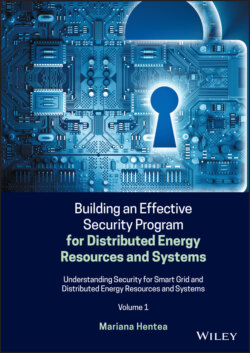Читать книгу Building an Effective Security Program for Distributed Energy Resources and Systems - Mariana Hentea - Страница 2
Table of Contents
Оглавление1 Cover
2 Title Page
3 Copyright Page
4 Dedication Page
5 Foreword
6 Preface Volume 1
7 Acknowledgments
8 Part I: Understanding Security and Privacy Problem 1 Security 1.1 Introduction 1.2 Smart Grid 1.3 Distributed Energy Resources 1.4 Scope of Security and Privacy 1.5 Computing and Information Systems for Business and Industrial Applications 1.6 Integrated Systems in a Smart Grid 1.7 Critical Smart Grid Systems 1.8 Standards, Guidelines, and Recommendations 2 Advancing Security 2.1 Emerging Technologies 2.2 Cybersecurity 2.3 Advancing Cybersecurity 2.4 Smart Grid Cybersecurity: A Perspective on Comprehensive Characterization 2.5 Security as a Personal, Organizational, National, and Global Priority 2.6 Cybersecurity for Electrical Sector as a National Priority 2.7 The Need for Security and Privacy Programs 2.8 Standards, Guidelines, and Recommendations References Part 1
9 Part II: Applying Security Principles to Smart Grid 3 Principles of Cybersecurity 3.1 Introduction 3.2 Information Security 3.3 Security‐Related Concepts 3.4 Characteristics of Information 3.5 Information System Characteristics 3.6 Critical Information Systems 3.7 Information Security Models 3.8 Standards, Guidelines, and Recommendations 4 Applying Security Principles to Smart Grid 4.1 Smart Grid Security Goals 4.2 DERInformation Security Characteristics 4.3 Infrastructure 4.4 Smart Grid Infrastructure 4.5 Building an Information Infrastructure for Smart Grid 4.6 IT Systems Versus Industrial Control System Infrastructure 4.7 Convergence Trends 4.8 Standards, Guidelines, and Recommendations 5 Planning Security Protection 5.1 Threats and Vulnerabilities 5.2 Attacks 5.3 Energy Sector: Threats, Vulnerabilities, and Attacks Overview 5.4 Security Controls 5.5 Security Training and Skills 5.6 Planning for Security and Privacy 5.7 Legal and Ethical Issues 5.8 Standards, Guidelines, and Recommendations References Part 2
10 Part III: Security of Critical Infrastructure 6 Critical Infrastructure 6.1 Introduction 6.2 Associated Industries with Critical Infrastructure 6.3 Critical Infrastructure Components 6.4 Energy Sector 6.5 Critical Infrastructure Interdependencies 6.6 Electrical Power System 6.7 Recent Threats and Vulnerabilities 6.8 Standards, Guidelines, and Recommendations 7 Critical Infrastructure Protection 7.1 Critical Infrastructure Attacks and Challenges 7.2 The Internet as a Critical Infrastructure 7.3 Critical Infrastructure Protection 7.4 Information Security Frameworks 7.5 NIST Privacy Framework 7.6 Addressing Security of Control Systems 7.7 Emerging Technologies and Impacts 7.8 Standards, Guidelines, and Recommendations References Part 3
11 Part IV: The Characteristics of Smart Grid and DER Systems 8 Smart Power Grid 8.1 Electric Power Grid 8.2 Smart Grid: What Is It? 8.3 Smart Grid Characteristics 8.4 Smart Grid Conceptual Models 8.5 Power and Smart Devices 8.6 Examples of Key Technologies and Solutions 8.7 Networking Challenges 8.8 Standards, Guidelines, and Recommendations 9 Power System Characteristics 9.1 Analysis of Power Systems 9.2 Analysis of Impacts 9.3 Reliability 9.4 Resiliency 9.5 Addressing Various Issues 9.6 Power System Interoperability 9.7 Smart Grid Interoperability Challenges 9.8 Standards, Guidelines, and Recommendations 10 Distributed Energy Systems 10.1 Introduction 10.2 Integrating Distributed Energy Resources 10.3 DER Applications and Security 10.4 Smart Grid Security Goals 10.5 Security Governance in Energy Industry 10.6 What Kind of Threats and Vulnerabilities? 10.7 Examples of Smart Grid Applications 10.8 Standards, Guidelines, and Recommendations References Part 4
12 Part V: Security Program Management 11 Security Management 11.1 Security Managements Overview 11.2 Security Program 11.3 Asset Management 11.4 Physical Security and Safety 11.5 Human and Technology Relationship 11.6 Information Security Management 11.7 Models and Frameworks for Information Security Management 11.8 Standards, Guidelines, and Recommendations 12 Security Management for Smart Grid Systems 12.1 Strategic, Tactical, and Operational Security Management 12.2 Security as Business Issue 12.3 Systemic Security Management 12.4 Security Model for Electrical Sector 12.5 Achieving Security Governance 12.6 Ensuring Information Assurance 12.7 Certification and Accreditation 12.8 Standards, Guidelines, and Recommendations References Part 5
13 A Cybersecurity Concepts References
14 B Power Grid Concepts B.1 Basic Terms B.2 US Electric Power Industry Overview B.3 Examples of Power Grid Glossaries References
15 C Critical Infrastructures Concepts C.1 Critical Infrastructures: Plans, Regulations, Frameworks, Programs References
16 D Smart Grid Concepts D.1 US Smart Grid Policy D.2 Smart Grid Definitions and Vision D.3 Examples of Smart Grid Technologies D.4 A Smart Grid Diagram: Past, Present, and Future D.5 Smart Grid Conceptual Model References
17 J Acronyms
18 Index
19 End User License Agreement
